AMD unveiled its Ryzen 7000 series of desktop processors on Monday, with enormous increases over its predecessors in performance, clock speed, and (in some cases) power. But AMD’s top-end 7950X will also be priced at $699, which is also $100 less than the price of the Ryzen 5950X when it debuted in late 2020.
And here’s a comparison you don’t see very often: AMD says its “worst” Ryzen 7000 processor will outperform Intel’s best 12th-gen”Alder Lake” chip, too.
AMD’s new processors are the first built using the company’s “Zen 4” architecture, which will kick off similar offerings in laptops, probably in January 2023, as well as servers. Ryzen 7000 is the first of AMD’s 5nm processors, and also the first to use its new AM5 motherboard socket. Enthusiasts will have to buy new motherboards to fit the new processors, in other words, but AMD has signaled that it hopes AM5’s longevity will rival the record-breaking endurance of the AM4 socket used by all previous Ryzen processors to this point.
The story of the new Ryzen 7000 processors, however, appears to be pure, raw performance. Recall how the Ryzen 9 5950X topped out at a 4.9GHz burst clock — the new 7950X’s base clock is 4.5GHz, and it will boost up to 5.7GHz when needed, a whopping 800MHz more. In fact, all four processors that make up the initial Zen 4 desktop family — the Ryzen 7600X, 7700X, 7900X, and the 7950X — perform similarly.
Even AMD itself was a little shocked at how well its new Ryzen 7000 processors performed. AMD chief executive Dr. Lisa Su told analysts and reporters in a press event in Austin, Texas that its designers expected 8 percent to 10 percent improvements in instructions per clock (IPC) compared to the Ryzen 5000/Zen 3 chips. In reality, AMD achieved 13 percent higher IPC. That, combined with the increases in clock speed, pushed the Ryzen 7000’s overall single-threaded performance up by an extraordinary 29 percent compared to Ryzen 5000. Naturally, AMD is claiming a performance advantage over Intel, specifically a 5 percent improvement in gaming over Intel’s 12th-gen “Alder Lake” chips.
“These are just huge performance increases, and I’m extremely proud of what the team was able to do to deliver it,” Su said.
AMD Ryzen 7000: speeds, and prices
Unlike Intel, which is pursuing a policy of disaggregation which could complicate how its chips are described, AMD’s new Ryzen 7000 processors are more straightforward, and they’ll all be available on Sept. 27. Here’s how fast the Ryzen 7000 family will be, and how much the Ryzen 7000 chips will cost:
- Ryzen 7950X: 16 cores/32 threads, 4.5GHz base/5.7GHz turbo (170W TDP), $699
- Ryzen 7900X: 12 cores/24 threads, 4.7GHz base/5.6GHz turbo (170W TDP), $549
- Ryzen 7700X: 8 cores/16 threads, 4.5GHz base/5.4GHz turbo (105W TDP), $399
- Ryzen 7600X: 6 cores/12 threads, 4.7GHz base/5.3GHz turbo (105W TDP), $299
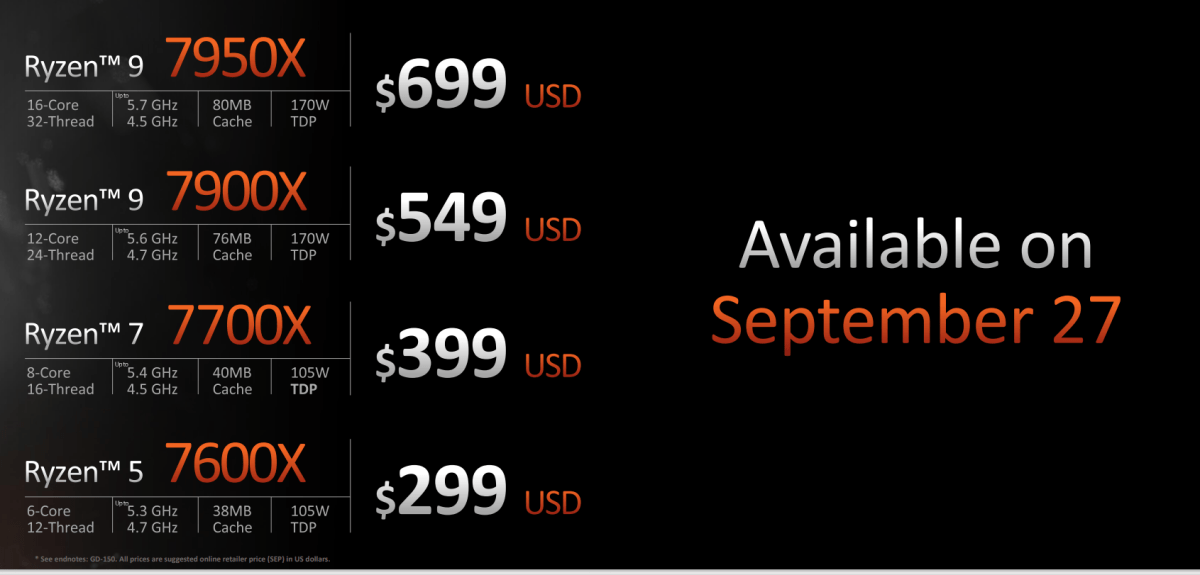
AMD
Su ascribed the performance improvements in part to the move to a 5nm process node, but also a new front-end architecture and support for AVX-512, a set of instructions used for high-performance computing that Intel adopted in 2020. AVX-512 hasn’t been a hit with some users such as Linux creator Linux Torvalds, who wrote that he hoped it would die a “painful death.”
But what are those performance improvements? As every chip manufacturer does, AMD picked a few benchmarks to show the new Ryzen 7000 processors in a favorable light. But it also aggregated them together, demonstrating that, across the board, the Ryzen 7000 handily outperforms its own Ryzen 5000 processors as well as the rival Alder Lake.
And not just a head-to-head battle, either. AMD pitted its “worst” processor, the new Ryzen 5 7600X, against Intel’s “best” 12th-gen Alder Lake, the Core i9-12900K. In F1 2022, the Ryzen 7600X generated an average frame rate of 447fps, 11 percent faster than the Core i9-12900K. That generally held up for a few more games, too.
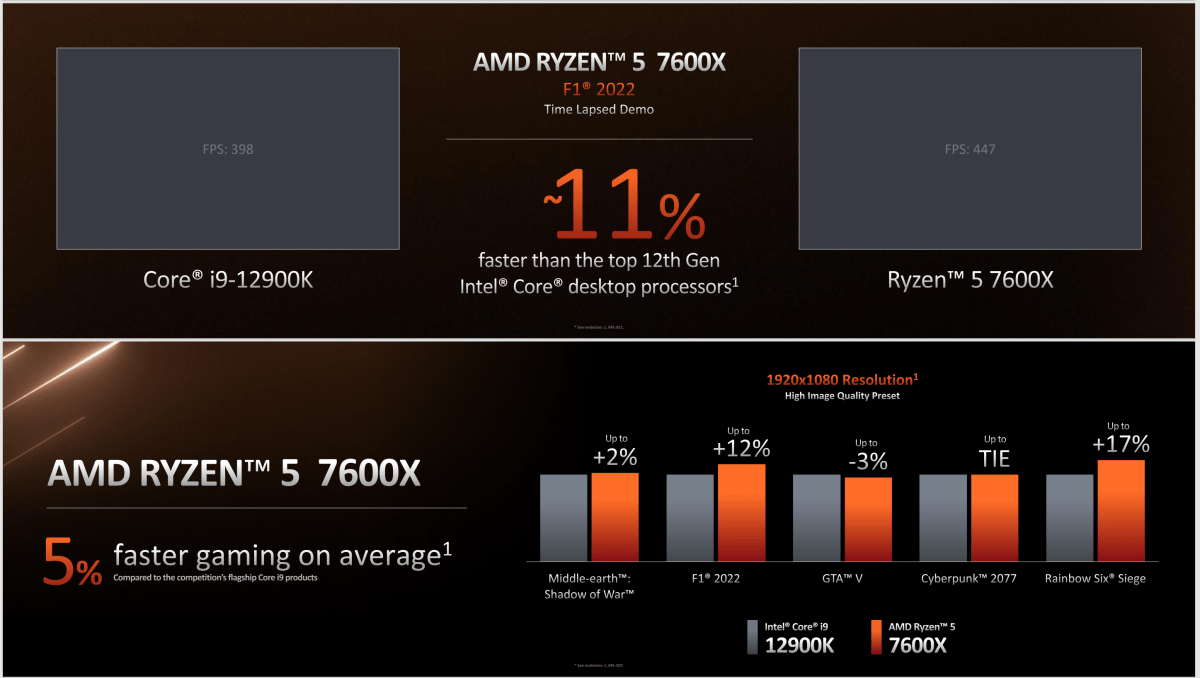
AMD
AMD also said that it averaged (or used a geomean, technically) about 13 percent more instructions per clock than the Zen 3/Ryzen 5000 architecture. That comparison used a fixed 4GHz frequency, with 8 cores and 16 threads, to generate a comparable result for each architecture.
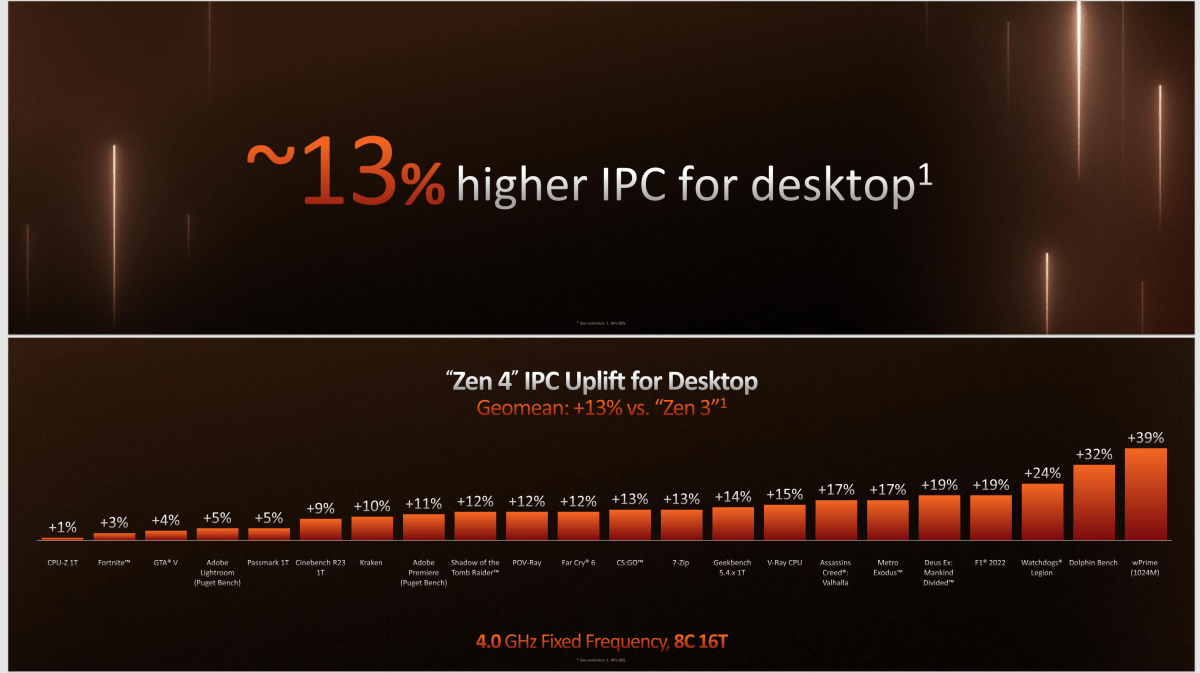
AMD
AMD believes that the Ryzen 7000 series is 74 percent more efficient than Ryzen 5000. AMD executives also noted that the Zen 4 cores (not the Ryzen 7000 processors themselves) measure 3.84 square mm, versus 7.46 square mm for Intel’s 7nm Alder Lake, or about half the die space. That’s good news for AMD’s profit margins, but won’t really affect enthusiasts.
This will: AMD also made the argument that Ryzen 7000 offers 49 percent more performance at the same power as the Ryzen 5000, or alternatively it can consume 62 percent lower power at the same performance as the Ryzen 5000. That’s the classic power-performance tradeoff that hints at what’s to come; notebook PC makers will have the option of dialing down the performance to extend battery life (a bit of a weak point in Ryzen laptops, until recent generations) or dial up the performance.
All told, the Ryzen 7000 delivers 11 percent faster single thread performance, 44 percent higher multi-threaded performance, and 47 percent more performance per watt than the competition, Su said.
“The 7950X is simply going to be the best CPU for gamers and for creators,” Su said. Compared to the competition, she said later, “you can see that the Ryzen 7950X is the fastest CPU in the world.”
Meet AMD EXPO, part of the Ryzen 7000 platform
People who buy AMD’s new Ryzen 7000 desktop processors will have to do something that hasn’t been absolutely required in years on Team Red: bid their old motherboards goodbye. AMD’s AM4 socket survived over 125 different AMD processors and more than 500 motherboards, but it’s being discarded in favor of the next-gen AM5 socket, a 1718-pin LGA socket that will be used with Ryzen 7000. (Intel’s Alder Lake uses a new LGA1700 socket, replacing the traditional LGA775 socket.) The plus, however, is that AM5 will be physically compatible with the AM4 socket in terms of cooling. If you have an existing Ryzen 5000 cooler, it will physically fit over a Ryzen 7000 chip in the AM5 socket.
Furthermore, executives also said that AMD has pledged AM5 support at least through 2025, continuing the legacy of the AM4 socket.
“As we turn our focus to the next generation of rising desktops, our goal of creating a platform that grows with you remains consistent,” David McAfee, corporate vice president and general manager of client channel business at AMD, told attendees.
AMD has designed and sold four AM5 motherboard chipsets that will support the Ryzen 7000 family: the X670 Extreme, the X670, the B650 Extreme and the B650, McAfee said. The X-series boards will be built with overclocking and power delivery in mind, supporting DDR5 memory and PCI Express 5.0. The “Extreme” boards, however, will enable PCIe 5 slots for both graphics and SSD storage, providing the best of both, McAfee said.
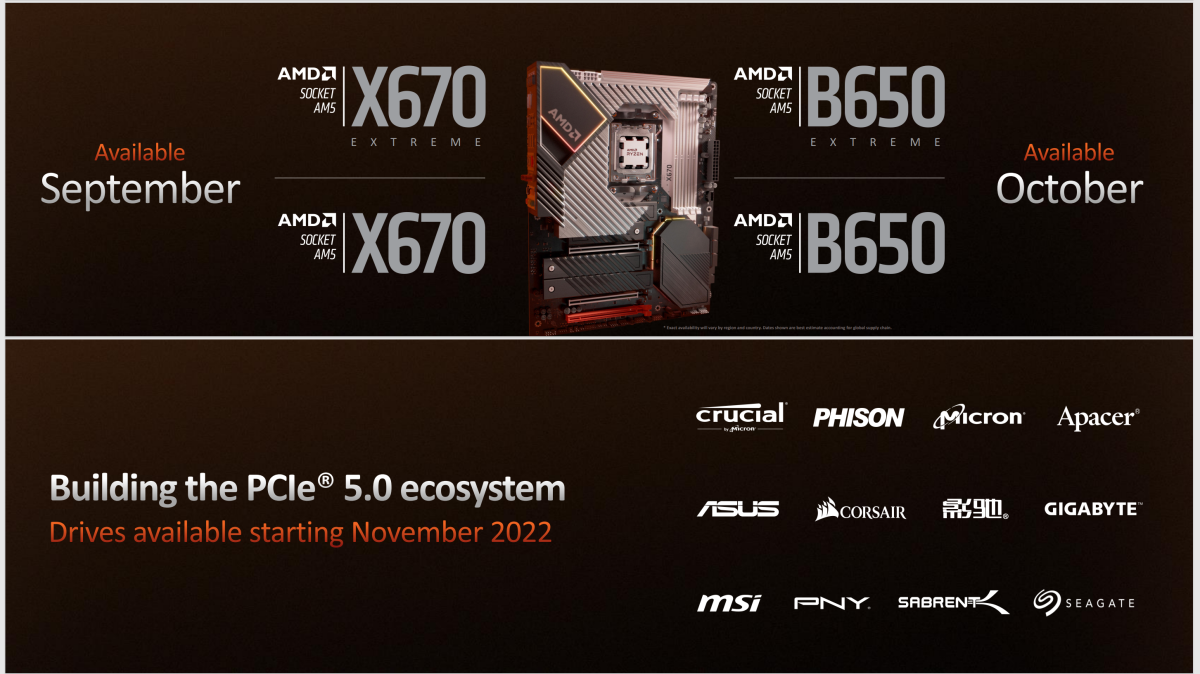
AMD
The “B ” boards will offer “next-generation technologies and great value for the end user,” McAfee said, without going into to many details. The B650 Extreme will offer similar capabilities as the X670 Extreme with PCIe 5 graphics and storage, though it’s not clear what the capabilities of each platform will be. You’ll be able to overclock Ryzen 7000 chips in all of them, though.
Basic motherboard pricing will begin at $125, AMD executives said. X-series boards will ship in September, and B-series board will ship in October. SSDs that use the PCIe 5.0 interface — from Crucial, Micron, Asus, Corsair, PNY, and others — will begin shipping in November, McAfee said, allowing system builders to combine all of the pieces of the platform then.
AM5 will also be predicated on DDR5 memory, which introduces something new to AMD’s platform: EXtended Profiles for Overclocking, also known as AMD EXPO.
AMD EXPO is AMD’s answer to Intel XMP 3.0, launched last year. Both XMP and EXPO allow DDR5 overclocking. At launch, AMD expects 15 EXPO-certified DDR5 RAM kits to be available, pushing standard DDR5-5200 RAM up to DDR-6400 speeds. That, according to McAfee, will boost gaming performance up to 11 percent and lower the memory latency down to 63ns.
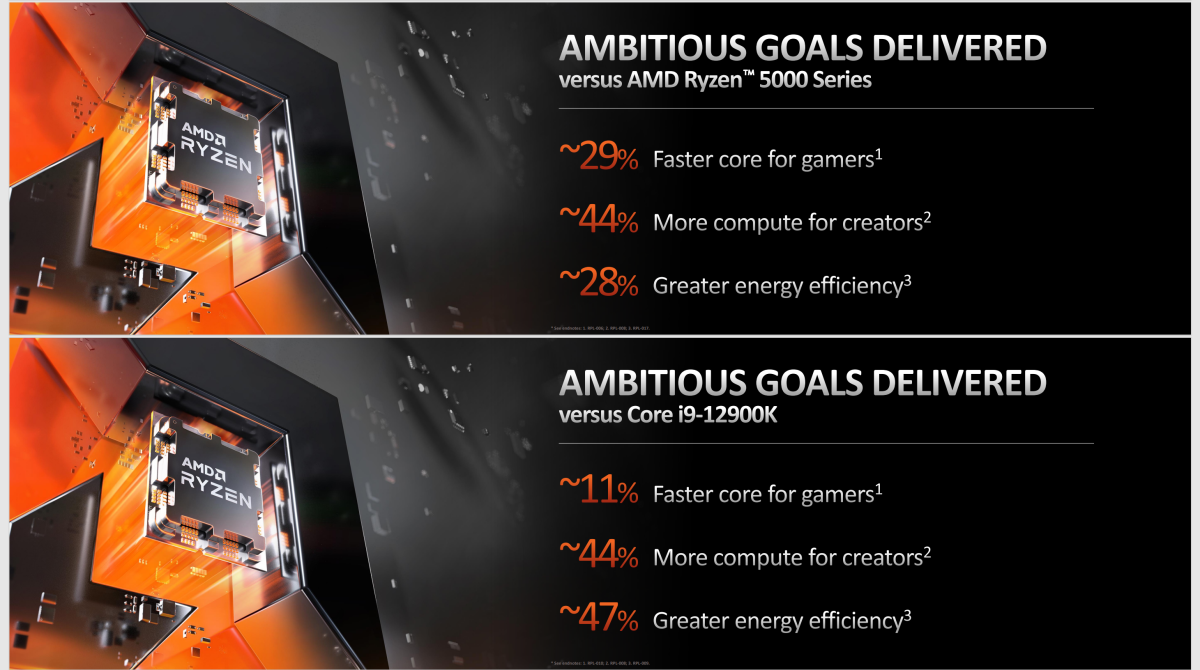
AMD
AMD didn’t choose to address the fairly dramatic increase in thermal power, aside from mentioning the cooler compatibility with AM4 boards. It’s worth noting that all but the Ryzen 5 5600X consumed 105W (the same as the 7600X and 7700X) while Intel’s Alder Lake chips are all “125W.” To be fair, though, that’s not quite true, either: Intel’s chips have a “maximum turbo power rating” that can go from 150W on up to 241W. Depending on what chip you buy, you can still make the argument that AMD’s Ryzen 7000 consumes less power, though the distinction is muddier than it used to be.
What’s next
Though the next addition to the Zen 4 lineup is due next year in the mobile space, AMD executives shared that the company is on track for a Ryzen 7000 chip with AMD’s V-Cache attached to ship “in the future,” according to AMD chief technical officer Mark Papermaster. V-Cache plops a massive slice of cache atop the chip die to increase gaming performance. AMD also plans a “Zen 4c,” a processor specifically developed for compact servers which don’t need high computing efficiency. Zen 5, a “ground-up core redesign with performance gains as well as further optimizations for AI workloads,” and is still due in 2024, he said.

AMD
Finally, AMD offered a look at its RDNA3 GPU architecture, which is up and running in AMD’s labs and will launch later this year, Su said. It, too, will be available on AMD’s 5nm technology and will deliver 50 percent more performance per watt than AMD’s current GPUs, she said.



